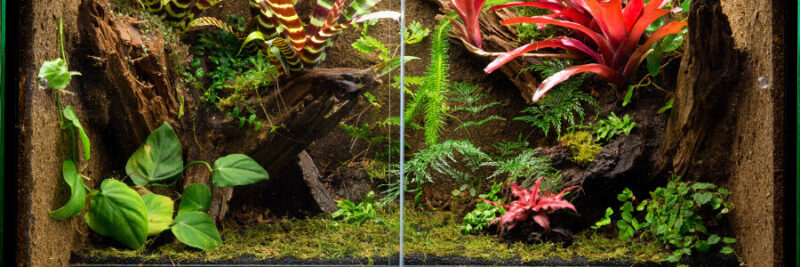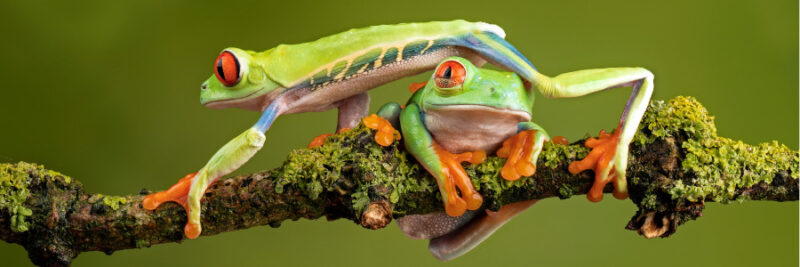Introduction to Red Eyed Tree Frogs
Hey there, future frog parents! You’re about to embark on an exciting journey into the world of red eyed tree frogs. These vibrant, nocturnal beauties, known scientifically as *Agalychnis callidryas*, are native to the rainforests of Central and South America. But guess what? They can thrive right in your home with the right setup and care.
Constructing Tropical Terrariums

Sizing & Materials
Let’s talk about your frog’s future pad. These frogs are arboreal, meaning they love to climb and hang out in trees. A vertical terrarium is ideal, something like an 18x18x24 inches enclosure for a pair of frogs. Glass terrariums with front-opening doors are perfect – easy for maintenance and great for observation.
Heating & Lighting
Red eyed tree frogs are tropical animals, so replicating their natural habitat is key. They thrive in temperatures around 75-80°F during the day, slightly cooler at night. Heating can be achieved through under-tank heaters or basking lights, but remember, it’s all about creating a gradient – warmer at the top, cooler at the bottom.
Lighting isn’t just for visibility; it’s about mimicking their natural light cycle. A 12-hour light/dark cycle is recommended. UVB lighting isn’t crucial for these frogs, but it doesn’t hurt, especially if you have live plants in the terrarium.
Furnishings & Substrates
The interior design of your terrarium should mimic a rainforest floor and canopy. Use substrates like coconut fiber or sphagnum moss to maintain humidity. Live plants like pothos or bromeliads not only look great but also help with humidity and provide climbing and hiding spots. Don’t forget a shallow water dish and some smooth branches or vines for climbing.
Feeding & Hydration
Whole Prey Diet
In the wild, red eyed tree frogs feast on a variety of insects. In captivity, a diet of crickets, moths, and the occasional fly will do. It’s vital to ‘gut load’ these insects before feeding – that means feeding your frog’s food nutritious foods. This process enriches their nutritional value. Also, dust the insects with a calcium supplement a couple of times a week to prevent nutritional deficiencies.
Misting & Hydration
Hydration is about more than just a water dish. These frogs absorb water through their skin, so a good misting system is essential. Mist your terrarium twice daily to maintain high humidity and provide droplets for your frogs to drink. Make sure the water you use is dechlorinated.
Handling & Interactions

Minimizing Handling Stress
Here’s the deal: red eyed tree frogs are not the cuddly type. They are delicate and can get stressed with handling. If you must move them, do so gently and infrequently. Always wash and rinse your hands before and after handling to protect both you and your amphibian friend from any cross-contamination.
Hygiene & Precautions
These frogs can carry salmonella, so hygiene is non-negotiable. Wash your hands thoroughly after any contact. And remember, it’s about mutual respect – handle them sparingly and gently.
Health & Common Issues

Signs of Illness
Keep an eye out for signs of distress or illness in your frogs. Lethargy, weight loss, discoloration, or reluctance to eat are all red flags. If your frog’s skin starts looking weird or if you notice any behavioral changes, it might be time for a vet visit.
Establishing Veterinary Care
Speaking of vets, having an exotic veterinarian who specializes in amphibians is crucial. Regular check-ups can help catch any health issues early on.
FAQ's for Red Eyed Tree Frogs
While they aren't the easiest pets, with the right setup and consistent care, they can be a rewarding choice for a dedicated beginner.
A vertical terrarium with plenty of humidity, appropriate temperature gradients, and ample foliage is ideal.
They require a warm environment. A heat pad can be used, but ensure it doesn't overheat the terrarium or create an unnatural temperature gradient.
While red eyed tree frogs are not the easiest, with commitment and proper care, they are a manageable and fulfilling choice.
This guide is just the beginning of your adventure with red eyed tree frogs. Remember, patience, consistency, and a passion for learning will make you an excellent amphibian caretaker. Enjoy the journey with these remarkable creatures, and keep exploring the wonderful world of herpetology!
